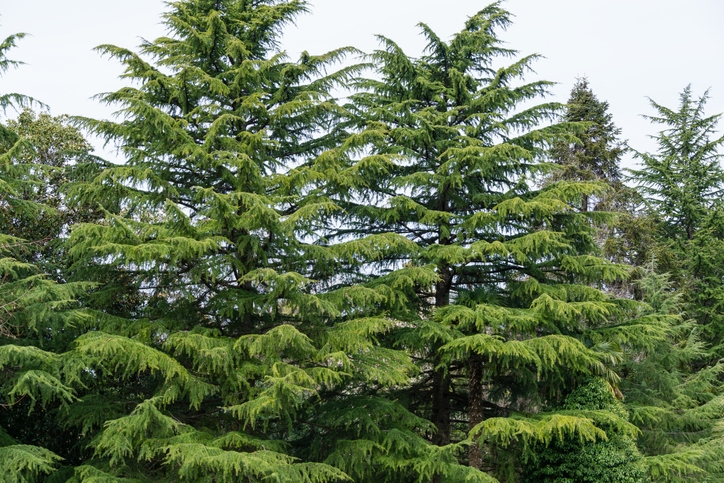The types of wood available are wide-ranging. While it’d be nice to go to the lumber yard and grab the cheapest species, different types of wood have different applications.
For woodworking or construction projects, this article will guide you to pick the right type of wood.
Different Types of Wood

Wood uses range from heating the house, starting fires, and cooking food to building furniture and houses from scratch.
Different wood types have different characteristics, making some types of wood more suitable for certain applications.
Let’s take a look at the most common types of wood species and what they’re best for.
Fir
Best For: Flooring, trim work, furniture-making, boats, and aircraft. But this species doesn’t accept stains well, so plan on using it in its natural reddish tint or painting it.
Fir is sometimes known as Douglas fir. Douglas fir trees are extremely tall, capable of reaching heights of up to 300 feet. Fir is a robust and durable softwood that’s highly insect and rot-resistant, although not to the same extent as cedar wood. Even though it’s a softwood, its durability rivals hardwood varieties.

The grain of Douglas fir is visible and runs straight. It’s also less expensive compared to other types of wood.
All of these qualities make it an ideal building material. However, you can also use it for decking and other woodworking projects. It’s sturdy and long-lasting, and it’s easy to cut when using construction saw blades.
Cedar
Best For: Decking, fences, outdoor furniture, wood shingles, interior finishes, and furniture making.
Cedar is a fragrant softwood prized for its beauty and longevity. Resistance to insects and rot are among its most valued characteristics.
Cedar wood comes from a range of coniferous trees, the most prevalent are red and white. White cedar is paler than red cedar, which has an amber-like look. Both versions weather to a silvery gray when left untreated and exposed to the elements.

Cedar is resilient and lightweight, and you’ll find it in a variety of indoor projects but also for exterior use, regardless of the variation.
The wood grain of the red variety is straighter, whereas white wood can absorb paint more evenly. Due to the aforementioned characteristics, it works really well for applications such as building material for chests or dressers but also for making decks, fences, and outdoor furniture.
Cedar belongs to the pine family but is more durable than standard pine wood. Unlike pine, you can use cedar as decking without having to stain or varnish it. Thanks to its ability to repel fungi, you can leave cedar outside for several decades. It is also less prone to mold.
Pine
Best For: Furniture making, flooring, cabinetry, and shelving. You can use pine for decking and outdoor projects, but make sure it’s pressure-treated.
Pine is a softwood that comes from a variety of trees found throughout the US. Some of the most common varieties include ponderosa, white, southern yellow pine, and sugar.
Pine is easy to work with, but unlike cedar, it’s not naturally rot and insect resistant. If you want to use pine for decking or an outside project, you’ll need pressure-treated southern yellow pine.

Pine wood is light, often with a yellow or orange appearance. It may also contain knots, with knotty parts labeled as “knotty pine” and knot-free sections promoted as “clear pine.” Overall, these wood types have a rough appearance and accept stains and paint well.
Low-grade pine is prone to warping and cupping. As this wood is rich in moisture, cheap cuts will buckle and twist when the wood dries out.
Redwood
Best For: Outdoor projects, beams, support posts, decking, and furniture.
Redwood, also known as sequoia, is one of the tallest trees on the planet, capable of reaching heights of up to 400 feet.
Redwood is a soft, pliable, and light wood. It can be a delicate white, yellow, deep crimson, or reddish-brown color. The wood grain is normally straight, with old-growth redwood being tight.
These wood types have a rough texture and resist rot and insect damage very well, making them an excellent choice for outdoor projects.

Redwood is a common choice for framing lumber, fences, decks, outside furniture, beams, and veneer. If it is pressure-treated, you can use it for projects that have ground contact.
Birch
Best For: Flooring, cabinetry, furniture making, wood veneers, and millwork.
Birch is widely used and is an economical hardwood. Birch grows throughout the eastern United States, especially in the Northeast.
These trees can grow up to 70 feet tall, but their trunks are slender. There are several birch varieties, but black, white, and yellow birch are the most popular.

Birch has a homogeneous look due to its smooth-grained wood. Its color ranges from white to yellow, while the variety known as black birch has black streaks running through it.
Birch is thick and sturdy but responds well to sharp tool woodworking. As it dries, it shrinks a considerable amount.
Ash
Best For: Staircase treads, tool handles, baseball bats, furniture, flooring, and trim.
Ash is a type of lumber derived from different types of ash trees. The most common varieties of these wood types are blue, white, green, and black ash. Ash will grow up to 60 feet tall and up to 80 feet wide if given enough space.

Ash lumber has a bright tint that ranges from white to gold, with gray streaks throughout. Although the colors are close to maple wood, ash wood has a texture similar to oak but with a rougher surface.
Ash is tough, but it’s light in comparison to its stiffness and durability. It has great shock-resistant qualities.
Maple
Best For: All types of interior projects, including flooring, furniture making, trim work, and cabinetry.
Maple trees can reach heights of 115 feet and have equally large canopies. The wood that comes from a hard maple is very solid and durable, with a nice light-colored look that ranges from white to yellow to a rich golden tint.
Sugar maple is one of the most valuable wood types in the northeastern United States.

Maple wood has a straight and tight grain with light brown bands. Curly maple wood, which has intriguing wavy wood grain patterns, is also available. Both grain varieties offer a smooth, delicate texture.
Because maple wood is relatively easy to work with, you can turn it into anything from baseball bats to paper. Manufacturers like to use it for a range of projects, from furniture and flooring to interior trims and veneer. It’s so hard-wearing and durable that it’s one of the best types of wood for making bowling lanes.
Mahogany
Best For: High-end furniture making, cabinets, paneling, musical instruments, and boats.
Mahogany is a premium wood that grows in West Africa, Central America, and South America. These trees can reach heights of over 150 feet.
Mahogany is the best hardwood for high-end projects. It features a deep crimson or brown-red color and has spectacular natural beauty.

Mahogany is a sturdy and heavy wood with a very smooth grain and fine texture. It also has a dense structure, making it resistant to rot and insects.
One of the best qualities of mahogany wood types is stability – it doesn’t warp, swell, or shrink.
The most common applications are high-end, custom kitchen cabinets along with furniture, but it’s also a popular choice for boat building because it’s hard-wearing.
Poplar
Best For: Furniture making, shed construction, cabinetry, and small woodworking projects.
Poplar wood comes from poplar trees, which grow throughout the Eastern United States and can reach up to 160 feet tall. This type of wood is popular among DIYers and hobbyist woodworkers due to its versatility.
Poplar is a light-colored wood that ranges from cream to yellowish-brown in color.

Common characteristics of poplar wood are green or gray streaks, which tend to darken over time. Poplar grain is straight, and its qualities make it compatible with the use of hand or power tools.
However, because it tends to leave fuzzy edges, fine-grit sandpaper is required for a smooth finish. While poplar isn’t a particularly attractive wood, it paints well, so you can use it for furniture.
Cherry
Best For: High-end furniture and cabinets, trim, flooring, musical instruments, and boat interiors.
Cherrywood is always in high demand. It ranges from creamy white to a reddish-brown color. When cherry wood reaches maturity, the wood becomes darker and drier.
Cherry wood has a straight and tight grain that gives it a consistent appearance and fine texture.

Cherry has one of the smoothest finishes possible, making it ideal for staining.
Manufacturers use the cherry wood variety for high-quality furniture, but also flooring, instruments, carvings, and more.
Walnut
Best For: Flooring, furniture making, cabinets, trims, wood veneer, and musical instruments.
Walnut lumber is derived from the black walnut tree, found throughout the eastern United States. These trees can reach a height of 120 feet and produce rich, chocolatey wood.
Walnut hardwoods have a straight grain, although it’s almost as likely to have waves and imperfections.

When you touch walnut wood, you will notice that it has a medium-smooth texture. The color of the wood ranges from light brown to dark brown.
Walnut is particularly resistant to decay, but has poor resistance to insects. It’s dimensionally stable, with very little shrinkage and warping as it cures.
Oak
Best For: Extreme versatility – flooring, furniture, whiskey barrels, cabinets, trim, and doors.
Oaks can reach heights of 85 feet and produce a cornucopia of acorns every fall.
There are two popular types of oak: red oak and white oak. Both are dense and robust, having a harsh, straight-grained texture. White oak wood has a lighter color, while the red variety has a warm red tone.

Even though oak is tough, it’s quite flexible. It’s a top choice for whiskey or wine barrels. This type of wood also makes its way into a lot of different products, from cabinets to furniture production.
Teak
Best For: Decking, outdoor furniture, indoor furniture, exterior building and siding, flooring, cutting boards, and boat decks.

Teak is a popular wood due to its durability and good looks.
Teak is coarse with an uneven texture and a straight grain. Natural oils in the wood make it resistant to rot and insects. These are qualities that make Teak a high-end choice for outdoor furniture manufacturing.
Despite the oils, teak is a simple wood to work with, bonding and finishing beautifully. There are plenty of similar traits between mahogany and teak, although teak is undeniably dark brown, whereas mahogany frequently has a red color.
Bamboo
Best For: Flooring, veneers, garden design, and furniture making.
Bamboo is popular for its sustainable nature. However, bamboo is technically a grass, not a type of wood.
Bamboo is abundant in tropical climates, with many different species available. It’s hard and durable, making it applicable to many woodworking projects.

Bamboo has long hollow stems that manufacturers can cut into very thin, narrow strips to make veneer for engineered wood products.
Because bamboo is lighter, many people think it’s softer, but it’s the opposite. In fact, bamboo has more properties in common with varieties like Red oak or Maple wood. This woody material is making its way into everything from fine woodworking to wood flooring.
Bamboo has a natural coating that makes it resistant to decay, so before you can stain or paint it, you must sand the coating off. The main drawback to bamboo is that it can swell in moist climates and shrink in dry ones.
Wood Types: Hardwoods or Softwoods?
What Is Hardwood?

A hardwood tree has broad leaves. Hardwoods yield nuts or fruits, and in the winter, they often fall dormant.
America’s forests have hundreds of distinct hardwood species that account for over 40% of trees in the United States. Oak, maple, and cherry are a few well-known hardwoods, but there are a lot more varieties.
Angiosperm trees are the main class of hardwood. They produce flowers, have broad leaves, and when they mature, the ovule surrounds their seed. A good example of this is the apple on an apple tree.
Hardwood trees that grow in tropical regions may shed their leaves in response to seasonal drought. Also, tropical types usually don’t have annual growth rings. Unlike softwood, these types of wood have a complex structure and grain. They are often slow-growing and require a lot of space to develop.
Most hardwoods are more rigid than softwoods, though there are some exceptions. In both cases, the wood can vary in its actual hardness. For instance, some types or hardwood trees produce soft wood.
What Is Softwood?

Softwood comes from gymnosperm trees. Spruce and pine are two common examples. Gymnosperms are plants that carry seeds in cones rather than flowers. These types of trees reproduce mostly through cones and, on rare occasions, nuts.
Softwood trees have needle-like leaves that mostly stay in place throughout the year. As a result, these are sometimes called evergreens.
A common misconception is that softwood trees are always softer than hardwood trees. In reality, the words softwood and hardwood are outdated, have ambiguous meanings, and frequently misrepresent the qualities of particular wood types.
Softwoods are common in the building sector, as well as in the production of card and paper-based products.
Because certain insects favor moist hardwood, certain softwood species have a higher resistance to insect attacks.
What Is Pressure-Treated Lumber?

Pressure-treated lumber is produced using water-borne chemicals and pressure power to impregnate the boards. These chemicals extend the life of the wood and make it more resistant to decay and insects.
Douglas fir and Southern yellow pine are the most common types of pressure-treated lumber. Both are suited for construction projects as they’re pest and rot-resistant.
When sealer is applied to pressure-treated lumber, it can last up to 40 years.
Types of Engineered Woods

- High-Density Fiber Board (HDF) – HDF is highly compressed wood fibers that come in sheets like plywood. Sometimes, this is topped with a wood veneer.
- Medium Density Fiberboard (MDF) – MDF is similar to HDF but less dense. Medium Density Fiberboard is better from an acoustic standpoint and is a good insulator. However, MDF is not good for woodworking, and there are concerns about the chemicals in these engineered wood products.
- Oriented Strand Board (OSB) – OSB is often a good alternative to using plywood. It’s composed of wood strands in a cross-hatched pattern combined with resin at high temperatures. It’s cheaper than plywood, so builders use it for new homes.
- Cross-laminated timber(CLT) – is a large-scale, prefabricated, solid-engineered wood panel.
Frequently Asked Questions (FAQ)FAQ
What are the main types of wood?
There are two basic varieties of wood: Hardwood and softwood.
Is cedar a hardwood?
No. Cedar wood is, in fact, a softwood variety, part of the same family as the pine tree.
How many different kinds of woods are there?
If you consider only the two types wood categories, softwood and hardwood, then there are two different kinds of wood. However, if you were to classify the types of wood on a more specific level, you’d get more than 50 varieties of other woods, from apple to zebrawood.
What are the three classifications of wood?
There are three major wood categories in the lumber and timber trade. These are hardwoods, softwoods, and pseudo-woods. The latter is a category of tree-like types of wood that includes bamboo and palm trees.
What are the two main types of timber?
Timber bears the same classification as regular wood, meaning that you have hardwood and softwood timber to choose from.
What is the strongest wood?
The strength of wood is based on a specific industry rating which uses the Janka hardness scale. This is a measurement of how many pounds of force (lbf) it takes to penetrate half of a wood’s face grain with a 0.444-inch steel ball. If the number is high, that means it takes a lot of force to perform this action, making this wood variety in question extremely strong and durable.
Now, based on this industry method of determining the hardness of wood, the Australian buloke is considered the strongest wood on the planet. It is an ironwood with a Janka hardness of 5,060 lbf.
What is the best type of wood for furniture?
The best type of wood for furniture depends on the usage. Teak is a champion in outdoor furniture production because of its natural oil contact and density. These qualities make it more weather resistant. Sheesham wood is flexible and tough, so builders often use it to make decorative items. Moreover, it works very well for furniture that has lots of curves that are otherwise more difficult to make.
Is chipboard a hardwood or softwood?
Also called particleboard, chipboard is an engineered wood product that is made with wood chips or jute-stick chips. Particleboard is often confused with an oriented strand board. Particleboard is a more uniform and cost-effective alternative to traditional wood and plywood. Its appearance is uniform and strong. Softwoods make up most chipboard.
Builders use hardwoods and softwoods for many of the same things, but softwoods are often less expensive and easier to work with.
As a result, softwoods account for over 80% of all timber. You can find softwoods in a wide range of applications, including building components, furniture, and fiberboard.
Hardwoods tend to cost more and aren’t as flexible as softwood, but have the advantage of being denser, which means they will last longer. As a result, hardwoods show up most often in high-end furniture, decks, flooring, and long-lasting construction.






